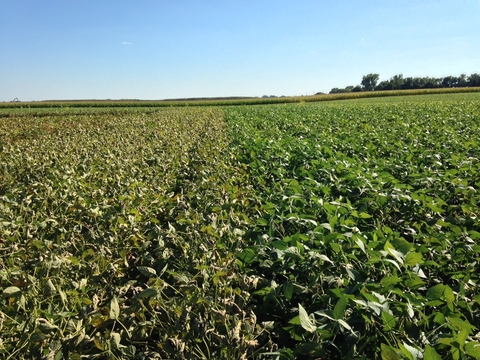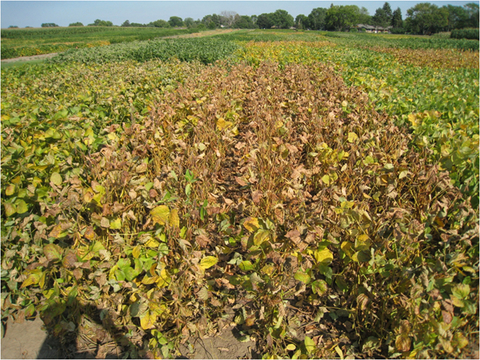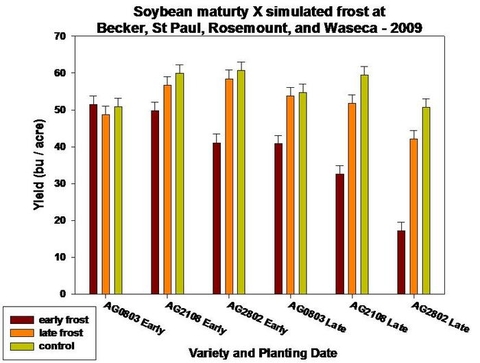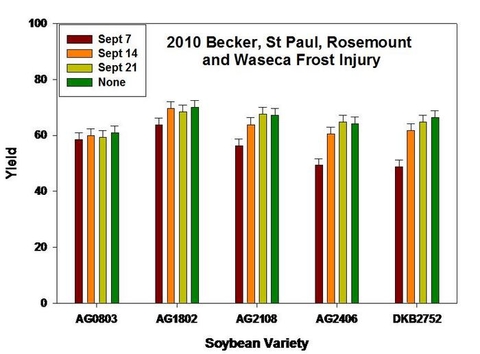Early frost can affect soybean yield and quality. However, the severity of frost damage greatly varies based on local climate conditions, topographical features, soybean management and growth conditions.
Factors affecting damage
Dense and lush soybean canopies tend to fend off severe freezes by holding heat within the canopy. Open canopies, on the other hand, tend to allow the cold air to access the lower canopy (Figure 1).
Late planting, soybean cyst nematode (SCN), iron deficiency chlorosis (IDC), and some conventional herbicides tend to promote open canopies. It’s likely these fields will be damaged more by frost than less stressed fields.
Likewise, soybeans nearing maturity tend to see deeper frost damage due to dropped leaves and open canopies. However, injury in the form of reduced yields is greatly reduced if frost hits as soybeans near the R7 growth stage (one mature colored pod on the main stem).
Estimating yield loss
Due to the variable nature of frost, yield loss estimates are quite difficult to come by. Yield and quality reductions depend on the crop stage when frost occurs and the frost’s severity.
Key findings
Researchers simulated frost with Liberty herbicide applications at a 32-ounce rate in early and late September on soybeans with a range of maturities. In addition, the trial also included a late planting date in 2009.
Under normal planting dates, early and normal maturity soybeans were not affected by frost – even at early September frost dates. Very late maturing soybean varieties saw yields reduce by 15 to 30 percent. Late planting (around May 21) drastically increased risk of frost damage in both early and late varieties.
These results highlight the large downside to planting full- and long-season soybeans in late May. Choosing an early-season soybean resulted in a small yield penalty when there wasn’t a terminal frost. Planting a very long-season variety late in May resulted in huge losses if a rare, very early frost were to take down the crop.
In this example, using an adapted line throughout late May strikes a nice balance between yield potential and risk aversion.
Methodology
In 2009, 2010 and 2011, soybean plots were established to investigate the yield effects of early frost on a range of soybean maturities.
In 2009, researchers examined three varieties with relative maturities (RM) of 0.8, 2.0 and 2.8. These were planted at a normal seeding date (around May 1) and at a late planting date (around May 21). Frost was simulated with applications of Liberty herbicide at a rate of 32 ounces per acre in 10 gallons of water on Sept. 7 (early) or Sept. 21 (late).
In 2010 and 2011, five varieties with maturity groups ranging from 0.8 to 2.8 were planted on a single planting date (early May) and treated to simulate frost on three dates (approximately September 7, 14 and 21).
Effect of maturity
Among the early-planted soybeans in 2009, simulated frost on Sept. 7 reduced seed yields of the adapted variety (AG2108) by 10 bushels per acre. The Sept. 21 frost did not significantly reduce the yields of the adapted variety.
In this case, the short-season soybean variety had a lower yield potential but was not affected by frost at any date. Alternatively, the very long-season variety (AG2802) showed a 20 bushel per acre yield reduction when “frosted” on Sept. 7. Again, the late September frost did not reduce yields for this variety.
Effect of planting date
When soybeans of all three maturities were planted late, early frost had a large yield effect. Frost in late September affected both the long-season variety as well as the adapted one. As expected, frost had a much larger effect on yields of late-planted soybeans.
This research highlights an important soybean management issue. Early planting did not benefit soybean yields in the absence of frost, except in the case where the soybean variety planted was of a much later than normally adapted maturity. Late planting primarily affected yield through increased losses due to early frost.
Results of the following year
Although fall conditions in 2010 were very different than 2009 conditions, yield responses to early frost were very similar:
-
Yields of the adapted variety were reduced by about 10 bushels per acre by a simulated frost on Sept. 7.
-
Yield losses were much smaller due to a Sept. 14 simulated frost, and nonexistent for a Sept. 21 simulated frost.
-
Again, the very long-season variety (DKB27-52) had yield reductions of about 20 bushels per acre when “frosted” early in September.
-
Frost effects from mid- and late-September events were relatively small.
While short-season soybeans are virtually frost-proof, only the very earliest frost
date tested reduced yields of the full- and long-season varieties below those of the very short-season variety. Short-season soybeans are not a good risk-management strategy unless planting dates get pushed back to the end of May.
The most often-cited study on frost damage to soybean was conducted in Kansas. Researchers grew soybeans of varying maturity in pots in the field and transported them to growth chambers set to 32 degrees Fahrenheit. They remained there until 80 percent of the leaves became visibly injured.
Plants were returned to the field and researchers determined yield at the end of the season. Yield data were a bit messy, but yield losses were estimated to be around 37 percent at R6 and 7 percent at R7. As one might expect, these yield losses closely follow those noted in defoliation studies.
Effect of development stage
During the R6 to R7 period, soybeans rapidly accrue yield. Damage will depend on the exact timing of the frost relative to development.
Hard-hit fields, or replanted areas that were close to R6 might see 30 to 40 percent yield reductions, while fields closer to R7 will only see minor effects. Fields with few yellow leaves showing prior to the frost will likely see significant yield loss, if a large portion of the canopy was damaged.
Frost effects on crop quality
Arresting soybean development late in seed fill tends to reduce yield because oil stops getting deposited in the seed. Oftentimes, frost-damaged seed is small, flat and green, with normal protein but low oil concentrations.
Handling frost-damaged grain
Mixing severely frosted grain with normal grain can potentially cause complications for the producer, from storage through marketing.
Grain from damaged areas can resist field dry-down and maintain excessive moisture levels through harvest. In addition, elevators may refuse loads with green soybean, or impose stiff dockages.
Isolate frost-damaged areas (especially late planted and/or drowned-out areas) and harvest them after the unaffected areas. While this can add logistical challenges for large operations, it could reduce the risks of storing damaged grain and will isolate potential dockages to individual loads rather than whole bins.
Saliba, M.R., Schrader, L.E., Hirano, S.S., & Upper, C. (1982). Effects of freezing field-grown soybean plants at various stages of podfill on yield and seed quality. Crop Science, 22 (1), 73-78. https://doi.org/10.2135/cropsci1982.0011183X002200010016x
Acknowledgements
Study 1 described above investigated the risks and benefits of long-season soybean varieties was established in 2008. This work was carried out by the Naeve Soybean Production Project, and was funded by the Minnesota Soybean Research & Promotion Council.
Reviewed in 2018





